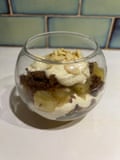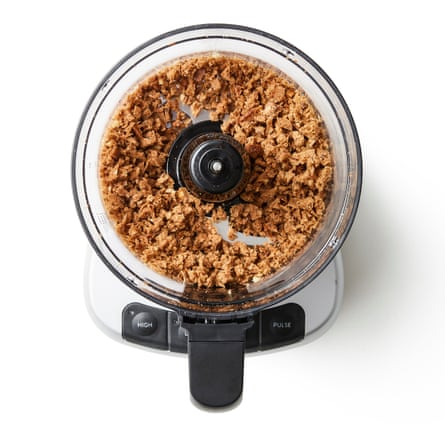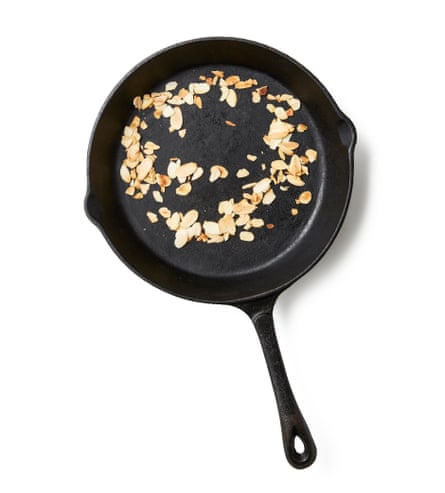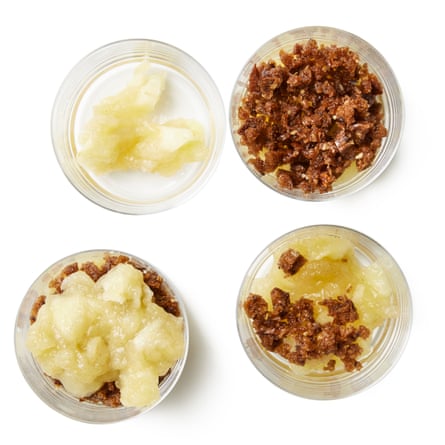Æblekage, the Danish term for a dish found throughout Scandinavia, translates as apple cake – rather misleadingly, because there’s no baking involved, unless you count the breadcrumbs that are traditionally scattered between the layers. That said, the Norwegian name, tilslørte bondepiker, means “veiled peasant girls”, which is even more confusing, given that the dish sits somewhere between a trifle and a charlotte. Perhaps the Swedish änglamat, or angel food, is the best description, because, as Signe Johansen writes in her book Scandilicious Baking, this “unusual combination” of ingredients “works so well – the apples are just sweet enough and fragrant with cinnamon, while the caramelised breadcrumbs add crunch and flavour”. This makes for a dish that is indeed “much fresher-tasting” than a traditional trifle, and perfect for marking the end of summer. Plus, it makes good use of both seasonal fruit and stale bread, so you get a lot of bang for your buck.

The apples
Should you be lucky enough to have your own glut of windfalls to deal with, you should almost certainly use them here, but if you’re gazing at the piles on offer at the market, or the glossily overpackaged fruits at the supermarket, then you may be interested to know that recipes are fairly evenly divided between those that recommend cookers (Johansen and Danish chef and food writer Trine Hahnemann’s The Scandinavian Cookbook), those that suggest a dessert variety (“tart … such as granny smiths” for Brontë Aurell in her book The ScandiKitchen, “fragrant” for Christine Rudolph and Susie Theodorou, authors of the book Copenhagen Cult Recipes) while Camilla Hawkins uses half cookers and half cox’s in her Danish mum’s recipe. (Fragrant I assume to mean something with a bit of flavour, rather than blandly beautiful big names.)
Though this need not be a particularly sweet dish, we find the varieties with the most acidity make the most satisfying partners for the other ingredients – bramleys or granny smiths would be my top picks of the most commonly found examples, though cox’s or braeburns are also good choices. Russets, though possessed of a fine flavour, will probably require a squeeze of lemon juice at the end, as will anything boringly sweet and juicy, naming no names.

Once you’ve obtained your apples, you need to decide what consistency you’d like them to bring to the dish. The Copenhagen Cult version, which feels the most restauranty in general (ie, the most complicated), sautes the diced fruit with butter and sugar to produce an almost tatin-like result in that the pieces retain their shape, rather than breaking down into a puree. The others all stew their fruit with a modest amount of sugar and, in most cases, a little water. Hahnemann cooks hers dry, but the bramleys I use prove remarkably reluctant to break down, so a very small amount helps, and does not dilute the flavour to any great extent. In any case, the “lumpy apple sauce” described by Hahnemann seems the ideal compromise; some puree is desirable to blend with the cream in a fool-type scenario, but it’s also pleasant to leave a little texture in there to remind you what you’re eating. (Aurell informs me that her mum favours a smoother finish.)
I always think apples work best with soft brown sugar, but if you have only white, then by all means use that; all the recipes I try do, which means it’s probably more in keeping with the original.
The crumbs

The main difference between this dish, in its many guises, and a British trifle is that breadcrumbs generally stand in for cake: caramelised croutons for Hahnemann, and crumbs fried in butter and sugar for Johansen and Aurell. Johansen calls for the dark rye variety (which, according to Aurell, makes itbrudepige med slør, which I find I prefer, first because they crisp up so beautifully, and second because their distinctive, sour flavour is a pleasant foil to the cream and apples, and make white crumbs taste rather boring in comparison.
Should you have a (not uncommon) horror of soggy bread, Hawkins notes that most Danes have their own way of making æblekage, and her mother’s involves oats rather than breadcrumbs, though similarly toasted in butter and sugar. Copenhagen Cult Recipes, meanwhile, make their own marzipan-flecked macaroons to crumble in, which, while delicious, could be easily substituted with amaretti, if you like the idea. I, however, favour the more savoury crumbs, which are crunchier than Hahnemann’s cubes or Hawkins’ oats, and less sugary than the biscuits.
The cream

As far as I can tell, this is not a dessert that goes overboard on the cream – I get a reprimand from someone online, who thinks I’ve put too much on a picture I post – but it’s what turns it from a workaday stewed apple dish to a real treat. You could just stick to double (or whipping cream, for a slightly lighter, airier result), but I love the two recipes from Johansen and Copenhagen Cult Recipes that combine it with creme fraiche to echo the tanginess of the apples. I’m also going to copy them in slightly sweetening the mix with sugar and vanilla, because plain cream always seems to me like a wasted opportunity. Don’t go overboard, though; this isn’t chantilly.
If you’re serving this immediately (of which more later), then it looks pretty to add a middle layer of cream to the dessert, but if not, then I’d save it all for the top, as whipped cream has a tendency to solidify unpleasantly when squashed up against acidic fruit.
The flavouring

This is a happily simple dessert, but if you’re feeling racy, there are options for glamming up your veiled farm girls. You could add lemon zest and verbena to the apples while they cook, as Copenhagen Cult Recipes suggests, or cinnamon (Johansen), or vanilla (Hawkins, Aurell and Hahnemann). You should certainly add a pinch of salt to the breadcrumbs, as Johansen recommends, and you might nod to the macaroon option by including some toasted almond flakes on top, as she does. Alternatively, serve the dish with rosehip preserve or redcurrant jelly on the side for a splash of colour, like Rudolph and Theodorou, or a grating of chocolate (Hawkins’ mother’s spin), which proves particularly popular with younger testers.
Opinions are divided as to whether this is a dish best devoured immediately or left to firm up for a couple of hours – Hawkins notes that “it is often served in the afternoon with coffee, and does solidify like a cake when left in the fridge”. As a devotee of all things crunchy, I’m in the first camp, but then again, I’m not averse to hoovering up the leftovers the next day – and if you’re keen to get ahead, you’ll be relieved to know that, as the apples and crumbs have to cool, it’s largely an assembly job just before serving. All you’ll have to do is whip the cream and layer it up, preferably in glass bowls, so the individual layers can be observed and, of course, admired.
Perfect æblekage

Prep 15 min, plus cooling
Cook 20 min
Serves 4
500g cooking apples or tart dessert apples (eg granny smith, cox)
½ tsp cinnamon (optional)
50g soft brown sugar, or ordinary white sugar
1 lemon (optional)
100g stale or well-toasted dark rye bread
1 tbsp flaked almonds (optional)
30g butter
40g white sugar, plus 1 tbsp extra for the cream
A pinch of salt
150ml double cream
100g full-fat creme fraiche, preferably the very thick French variety
½ tsp vanilla extract (optional)
Peel and core the apples, then roughly chop the flesh. Put this in a saucepan with a tablespoon of cold water, the cinnamon and the soft brown sugar.

Simmer gently until the fruit breaks down into a chunky puree, then taste, add a little lemon juice if necessary, and leave to cool.

While the apples are cooking, break the bread into pieces, then blitz to crumbs in a food processor – I like them quite coarse.

Toast the flaked almonds, if using, in a small, dry frying pan, until lightly golden, then tip out and set aside.

In the same pan, melt the butter and white sugar with a pinch of salt until bubbling, then stir in the breadcrumbs. Cook for two to three minutes, until well coated, then tip out of the pan and leave to cool.

When you’re ready to assemble, take four individual glass dishes (or one large one) and put half the apple mix in the base, followed by half the crumbs. Repeat the two layers.

Whip the cream, creme fraiche, vanilla extract, if using, and the extra tablespoon of white sugar to soft peaks, then spoon this on top of the dish. Top with the almonds, if using, and serve immediately, or chill for at least an hour, depending on preference.
Æblekage, tilslørte bondepiker, änglamat … whatever you call it, how do you like them apples? And what other desserts would you recommend to make the most of windfall season?
Bagikan Berita Ini














0 Response to "How to make the perfect æblekage, or Danish apple cake – recipe - The Guardian"
Post a Comment